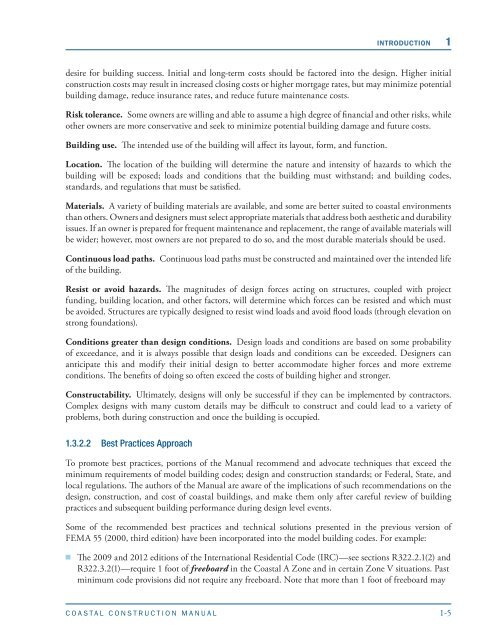Coastal Construction Manual - National Ready Mixed Concrete ...
Coastal Construction Manual - National Ready Mixed Concrete ...
Coastal Construction Manual - National Ready Mixed Concrete ...
Create successful ePaper yourself
Turn your PDF publications into a flip-book with our unique Google optimized e-Paper software.
INTRODUCTION 1<br />
desire for building success. Initial and long-term costs should be factored into the design. Higher initial<br />
construction costs may result in increased closing costs or higher mortgage rates, but may minimize potential<br />
building damage, reduce insurance rates, and reduce future maintenance costs.<br />
Risk tolerance. Some owners are willing and able to assume a high degree of financial and other risks, while<br />
other owners are more conservative and seek to minimize potential building damage and future costs.<br />
Building use. The intended use of the building will affect its layout, form, and function.<br />
Location. The location of the building will determine the nature and intensity of hazards to which the<br />
building will be exposed; loads and conditions that the building must withstand; and building codes,<br />
standards, and regulations that must be satisfied.<br />
Materials. A variety of building materials are available, and some are better suited to coastal environments<br />
than others. Owners and designers must select appropriate materials that address both aesthetic and durability<br />
issues. If an owner is prepared for frequent maintenance and replacement, the range of available materials will<br />
be wider; however, most owners are not prepared to do so, and the most durable materials should be used.<br />
Continuous load paths. Continuous load paths must be constructed and maintained over the intended life<br />
of the building.<br />
Resist or avoid hazards. The magnitudes of design forces acting on structures, coupled with project<br />
funding, building location, and other factors, will determine which forces can be resisted and which must<br />
be avoided. Structures are typically designed to resist wind loads and avoid flood loads (through elevation on<br />
strong foundations).<br />
Conditions greater than design conditions. Design loads and conditions are based on some probability<br />
of exceedance, and it is always possible that design loads and conditions can be exceeded. Designers can<br />
anticipate this and modify their initial design to better accommodate higher forces and more extreme<br />
conditions. The benefits of doing so often exceed the costs of building higher and stronger.<br />
Constructability. Ultimately, designs will only be successful if they can be implemented by contractors.<br />
Complex designs with many custom details may be difficult to construct and could lead to a variety of<br />
problems, both during construction and once the building is occupied.<br />
1.3.2.2 Best Practices Approach<br />
To promote best practices, portions of the <strong>Manual</strong> recommend and advocate techniques that exceed the<br />
minimum requirements of model building codes; design and construction standards; or Federal, State, and<br />
local regulations. The authors of the <strong>Manual</strong> are aware of the implications of such recommendations on the<br />
design, construction, and cost of coastal buildings, and make them only after careful review of building<br />
practices and subsequent building performance during design level events.<br />
Some of the recommended best practices and technical solutions presented in the previous version of<br />
FEMA 55 (2000, third edition) have been incorporated into the model building codes. For example:<br />
The 2009 and 2012 editions of the International Residential Code (IRC)—see sections R322.2.1(2) and<br />
R322.3.2(1)—require 1 foot of freeboard in the <strong>Coastal</strong> A Zone and in certain Zone V situations. Past<br />
minimum code provisions did not require any freeboard. Note that more than 1 foot of freeboard may<br />
COASTAL CONSTRUCTION MANUAL<br />
1-5







